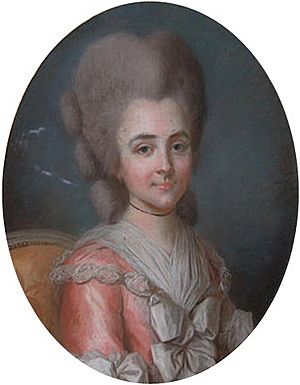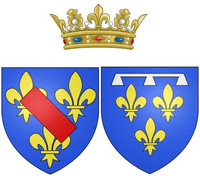Bathilde d'Orléans facts for kids
Quick facts for kids Bathilde d'Orléans |
|||||
|---|---|---|---|---|---|
| Princess of Condé | |||||

Portrait by Louis-Michel van Loo, around 1770.
|
|||||
| Born | 9 July 1750 Château de Saint-Cloud, France |
||||
| Died | 10 January 1822 (aged 71) Paris, France |
||||
| Burial | Chapelle royale de Dreux | ||||
| Spouse |
Louis Henri, Prince of Condé
(m. 1770; separated 1780) |
||||
| Issue | Louis Antoine, Duke of Enghien | ||||
|
|||||
| House | Orléans | ||||
| Father | Louis Philippe I, Duke of Orléans | ||||
| Mother | Louise Henriette de Bourbon | ||||
| Religion | Roman Catholicism | ||||
| Signature | |||||
Bathilde d'Orléans (born Louise Marie Thérèse Bathilde; 9 July 1750 – 10 January 1822) was a French princess. She was the sister of Philippe Égalité and the mother of the Duke of Enghien. She was also the aunt of Louis-Philippe, who later became King of the French. During the French Revolution, she was known as Citoyenne Vérité, which means "Citizen Truth". Because of her birth and marriage, she was considered a princess of the royal blood.
Contents
Early Life
Bathilde was born at the Château de Saint-Cloud in France on 9 July 1750. She was a descendant of both Louis XIV of France and his younger brother, Philippe of France. This meant she was a princess of the royal blood. Her parents were Louis Philippe d'Orléans and Louise Henriette de Bourbon. She was their youngest child.
Her mother passed away in 1759 when Bathilde was only eight years old. After this, her father sent her to live in a convent. While at the convent, she became a very religious person.
Marriage and Life in Paris
At first, Bathilde was thought to be a good match for Ferdinand, Duke of Parma. He was a distant cousin and the favorite grandson of King Louis XV of France. However, this marriage never happened.
In 1770, when she was twenty years old, Bathilde left the convent. She married her younger cousin, Louis Henri de Bourbon. He was the son and heir of Louis Joseph de Bourbon, Prince of Condé.
The couple separated in 1780. After their separation, Bathilde was not allowed to attend court events. She had to make a new life for herself at the Château de Chantilly. In 1787, she bought the Élysée Palace from King Louis XVI. She also had a small village-like area, called a hamlet, built there.
During the Revolution
During the French Revolution, Bathilde became interested in democracy, just like her brother Philippe Égalité. She disagreed with her husband and son, who supported the monarchy. Both of them left France after the storming of the Bastille. As the old system of government, known as the Ancien Régime, fell apart, she changed her name to Citoyenne Vérité. This meant "Citizen Truth."
The new revolutionary government threatened to take her wealth. To prevent this, she offered her money to the First French Republic. In April 1793, her nephew, the young Duke of Chartres, fled France. He sought safety with the Austrians. In response, the National Convention ordered that all members of the Bourbon family still in France be imprisoned.
While other members of her family were kept under house arrest, Bathilde, her brother Philippe Égalité, and his sons were sent to Fort Saint-Jean in Marseille. Even though she had supported the Revolution, she spent a year and a half in prison. In November of that year, her brother was executed by guillotine. Bathilde was lucky to survive the period known as the Reign of Terror. She was freed during the Thermidorian Reaction and returned to her home in Paris. She was very poor and had to rent out most of her palace.
Life in Exile
In 1797, the French government, called the Directoire, decided to send the remaining Bourbons out of France. Bathilde went to Spain with her sister-in-law, Louise Marie Adélaïde de Bourbon.
While in exile near Barcelona, Bathilde used her limited money to open a pharmacy and a place where poor people could get help. Her house became a place where those in need gathered. During this time, she became a strong supporter of the idea of a republic.
In 1804, she learned that Napoléon I, whom she admired, had ordered the capture and execution of her only son, Louis Antoine, Duke of Enghien. He was killed by a firing squad at the Château de Vincennes. For ten years, Napoleon prevented Bathilde from returning to France. She got her revenge in 1814. As she traveled back to Paris, people cheered for her. They saw her as the mother of the "Martyr of Vincennes."
Return to France
In 1815, when the Bourbon Restoration began, Bathilde returned to France. King Louis XVIII exchanged the Hôtel Matignon with her for the Élysée Palace. Bathilde quickly set up a community of nuns there. She asked them to pray for the souls of those who had died during the Revolution.
Her family wanted her to reunite with her husband after being separated for thirty-five years, but she refused.
In 1822, while taking part in a march towards the Panthéon, she fainted. She passed away in the home of a law professor who taught at the Sorbonne. After her death, her nephew, Louis-Philippe, burned her personal writings and a file about a police officer. He wanted to make her life seem more proper.
She was buried in the Orléans family chapel, the Collégiale de Dreux.
Children
- Louis Antoine Henri de Bourbon, (2 August 1772 – 21 March 1804) known as the Duke of Enghien.
Titles and Styles
- 9 July 1750 – 24 April 1770 Her Serene Highness Mademoiselle
- 24 April 1770 – 2 August 1772 Her Serene Highness The Duchess of Enghien
- 2 August 1772 – 18 May 1818 Her Serene Highness The Duchess of Bourbon
- 18 May 1818 – 10 January 1822 Her Serene Highness The Princess of Condé
Images for kids
-
Children of the Duke of Orléans (around 1755). Bathilde is holding an angel, with her brother, the young Duke of Chartres, on the far right. Painted by François-Hubert Drouais.
See also
 In Spanish: Batilde de Orleans para niños
In Spanish: Batilde de Orleans para niños






